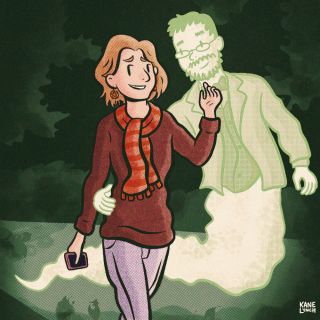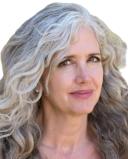Parapsychology
Why It's Normal to Believe in the Paranormal
Psychology explains paranormal beliefs despite scant scientific evidence.
Updated October 24, 2023 Reviewed by Ray Parker
Key points
- Beliefs in the paranormal, like interaction between the living and the dead, are common in the United States.
- Psychologists link paranormal belief to weak reality testing: the ability to tell what's real from what's not.
- Cognitive and motivational biases, distrust in science, and sensory perception can explain paranormal belief.
- Non-scripted paranormal TV shows fuel paranormal belief with dramatic imagery and manufactured credibility.

It’s fun to think about what people believe and why they believe it. This, too, is part of psychology. This time of year, it’s interesting to think about beliefs in the paranormal.
Paranormal Beliefs Are Common in U.S.
Most Americans (70 percent) believe some interaction is possible between the living and the dead, according to the Pew Research Center. Some 44 percent agree they’ve felt the presence of a deceased person.
Smaller percentages report getting help from the dead (20 percent) and personally communicating with the dead (14 percent). And according to Ipsos, close to half (46 percent) say they believe ghosts are real.
Interest in and studying the paranormal goes back to the beginning of psychology in the late 1800s. However, given the relative lack of scientific support for the existence of the paranormal, today, most psychologists relegate paranormal belief to a weakness in the “reality testing process.”
That is the ability to distinguish between what is real and what is not. Indeed, some research finds that paranormal beliefs are associated with cognitive biases, such as jumping to conclusions based on their emotional appeal and interpreting random events as meaningful.
For instance, you can see how some people might want to see something that occurs in their environment (a sound, a breeze, a creak, a penny, a smell, a song, etc.) as an indicator a deceased loved one is communicating with them, or that spirits are present. From a psychodynamic perspective, believing is motivated reasoning that may reduce grief, existential anxiety, and fear of death.
Death can also represent the end of a relationship; some paranormal beliefs allow for a continued relationship. There is even some evidence of brain differences between believers and non-believers.
The Role of Scientific Literacy
It's also true that paranormal belief is associated with lower scientific literacy and scientific values (understanding science and scientific methods and trusting science). I wonder if a rise in their paranormal beliefs will accompany the trend among some American groups toward distrusting science and scientists.
But it also seems likely that scientifically minded people may be less inclined to admit to paranormal belief with its lack of scientific confirmation and contradiction of basic scientific principles. I struggle with this myself. Believing flies in the face of my training and scientific mindset, yet I find myself attracted to the idea that spirits are among us, and it is something I have “felt.”
I also know the history of science is replete with examples of things we did not know until we figured out scientific ways to see and study them, and sometimes, I wonder if this could be one of them.
But as a psychologist, I recognize how minds can play tricks. I know how believing leads to seeing almost as much as seeing leads to believing (what is known as confirmation bias). I know how we perceive sensory inputs from the physical environment (environmental perception) is an interpretative process.
Hallucinations mimicking supernatural experiences have been induced in laboratory settings, and researchers suggest they result from how the brain processes unexpected sensory information. Therefore, I question my paranormal beliefs and experiences, taking them with a grain of salt and a saltshaker.
The Role of the Media
To some extent, the media have mainstreamed paranormal belief and increased social acceptance. Non-scripted shows like Ghost Hunters, Ghost Adventures, and The Dead Files, among others, are very popular. They play an interesting role in paranormal beliefs in responding to market demand from believers but promoting even stronger belief (and increased demand).
From a cognitive psychology perspective, these shows make it easier to imagine that spirits are among us and that the dead communicate with the living. This is consistent with the short-cut inference strategy called the availability heuristic (the easier something is to imagine, the more probable we judge it to be).
From a social-psychological perspective, these shows fuel belief because they are persuasive. The science of persuasion demonstrates the role of the information source in influencing us, particularly the appearance of trustworthiness, objectivity, and expertise.
Investigators seem trustworthy and unbiased, and many are open to “debunking” paranormal claims. They are presented as paranormal experts who use scientific-appearing equipment and scientific-sounding jargon (which may enhance their believability even with those holding scientific values). They confidently provide seemingly plausible explanations for the existence of paranormal phenomena.
The shows also employ dramatic and sincere testimonials from people claiming to have personal experiences with the paranormal. Vivid stories and the superficial appearance of credibility are known to be more persuasive than facts for those less in need of cognition (those who don't enjoy effortful thinking). These shows are compelling and persuasive, especially if you don’t question the role of the producers in manufacturing the appearance of credibility, and of course if you want to believe.
For my other essays on Halloween-related topics, read Very Superstitious (Why are people superstitious?) and Candy, Costumes, and Scares, Oh My! (Why do people "like" to be scared?)
References
Coelho, G.H.P., Hanel, P.H.P., & J. Wolf, L.J. (2020). The very efficient assessment of need for cognition: Developing a six-item version. Assessment, 27, 1870-1885.
Fasce A., Picó A. (2019). Science as a vaccine. Science & Education, 28(1–2), 109–125.
Fiorito T. A., Abeyta A. A., Routledge C. (2020). Religion, paranormal beliefs, and meaning in life. Religion, Brain & Behavior, 1–8.
ackson, C., & Yi, J. (2019). Less than half of Americans believe ghosts are real. Ipsos. https://www.ipsos.com/en-us/news-polls/halloween-2019
Kambhampathy, A.P. (2021). Many Americans believe in ghosts, do you? New York Times.
https://www.nytimes.com/2021/10/28/style/do-you-believe-in-ghosts.html
Orepic, P., Bernasconi, F., Faggella, M., Faivre, N., & Blanke, O. (2023). Robotically-induced auditory-verbal hallucinations: Combining self-monitoring and strong perceptual priors. Psychological Medicine, 1-13. doi:10.1017/S0033291723002222
Petty, R. E., & Cacioppo, J.T. (1986). The elaboration likelihood model of persuasion.
In Advances in Experimental Social Psychology, 19, 123-205.
Pew Research Center. (2021). Few Americans blame God or say faith has been shaken amid pandemic, other tragedies. https://www.pewresearch.org/religion/2021/11/23/views-on-the-afterlife/#most-believe-some-interaction-is-possible-between-the-living-and-the-dead
Williams, C., Denovan, A., Drinkwater, K., & Dagnall, N. (2022). Thinking style and paranormal belief: the role of cognitive biases. Imagination, Cognition and Personality, 41, 274-298.




